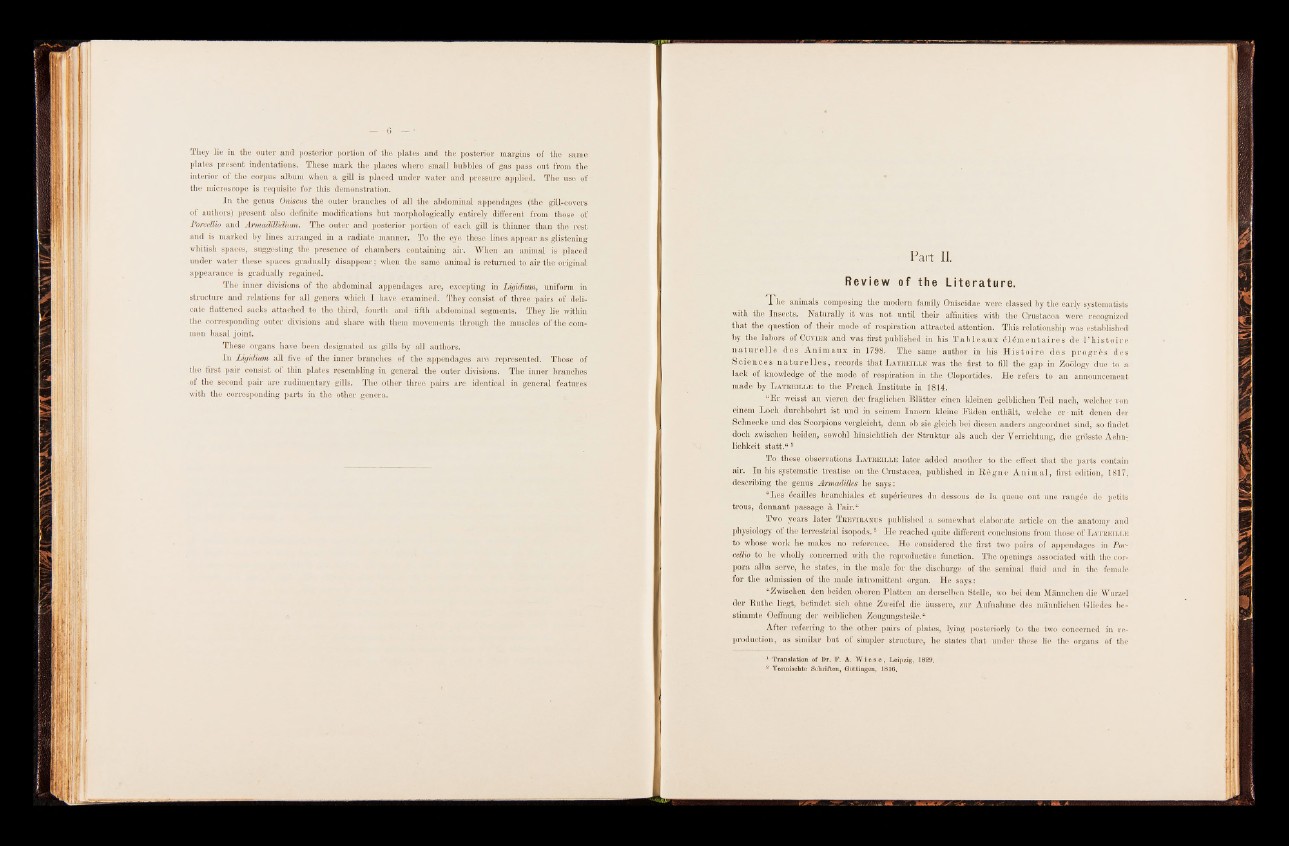
They lie in the outer and posterior portion of the plates and the posterior margins of the same
plates present indentations. These mark the places where small bubbles of gas pass out from the
interior of the corpus album when a gill is placed under water and pressure applied. The use of
the microscope is requisite for this demonstration.
In the genus Oniscus the outer branches of all the abdominal appendages (the gill-covers
of authors) present also definite modifications but morphologically entirely different from those of
PorceUio and Armadillidium. The outer and posterior portion of each gill is thinner than the rest
and is marked by lines arranged in a radiate manner. To the eye these lines appear as glistening
whitish spaces, suggesting the presence of chambers containing air. When an animal is placed
under water these spaces gradually disappear; when the same animal is returned to air the original
appearance is gradually regained.
The inner divisions of the abdominal appendages are, excepting in Ligidium, uniform in
structure and relations for all, genera which I have examined. They consist of three pairs of delicate
flattened sacks attached to the third, fourth and fifth abdominal segments. They lie within
the corresponding outer divisions and share with them movements through the muscles of the common
basal joint.
These organs have been designated as gills by all authors.
In Ligidium all five of the inner branches of the appendages are represented. Those of
the first pair consist of thin plates resembling in general the outer divisions. The inner branches
of the second pair are rudimentary gills. The other three pairs are identical in general features
with the corresponding parts in the other genera.
Part II.
R e v iew o f th e L ite r a tu r e .
T h e animals composing, the modern family Oniscidae were classed hy the early systematists
with the Insects. Naturally it was not until their affinities with the Crustacea were recognized
that the question of their mode of respiration attracted attention. This relationship was established
by the labors of C u v i e r and was first published in his T a b le a u x é lém e n ta ir e s de l ’h is to ir e
n a tu r e lle des A n im au x in 1798. The same author in his H is to ir e des p ro g r ès des
S c ie n c e s n a tu r e lle s , records that L a t r e i l l e was the first to fill the gap in Zoology due to a
lack of knowledge of the mode of respiration in the Cloportides. He refers to an announcement
made by L a t r e i l l e to the French Institute in 1814.
“Er weisst an vieren der fraglichen Blätter einen kleinen gelblichen Teil nach, welcher von
einem Loch durchbohrt ist und in seinem Innern kleine Fäden enthält, welche er • mit denen der
Schnecke und des Scorpions vergleicht, denn ob sie gleich bei diesen anders angeordnet sind, so findet
doch zwischen beiden, sowohl hinsichtlich der Struktur als auch der Verrichtung, die grösste Aehn-
lichkeit statt.“1
To these observations L a t r e i l l e later added another to the effect that the parts contain
air. In his systematic treatise on the Crustacea, published in R èg n e A n im a l, first edition, 1817,
describing the genus Armadilles he says:
“Les écailles branchiales et supérieures du dessous de la queue ont une rangée de petits
trous, donnant passage à l’air.“
Two years later T r e v i r a n u s published a somewhat elaborate article on the anatomy and
physiology of the terrestrial isopods.2 He reached quite different conclusions from those of L a t r e i l l e
to whose work he makes no reference.- He considered the first two pairs of appendages in PorceUio
to be wholly concerned with the reproductive function. The openings associated with the corpora
alba serve, he states, in the male for the discharge of the seminal fluid and in the female
for the admission of the male intromittent organ. He says:
“Zwischen den beiden oberen Platten an derselben Stelle, wo bei dem Männchen die Wurzel
der Ruthe liegt, befindet sich ohne Zweifel die äussere, zur Aufnahme des männlichen Gliedes bestimmte
Oeffnung der weiblichen Zeugungsteile. “
After referring to the other pairs of plates, lying posteriorly to the two concerned in reproduction,
as similar but of simpler structure, he states that under these lie the organs of the
1 T ra n s la tio n o f D r. P. A. W i e s e , Le ipz ig, 1829,
a V e rm isch te Sch riften , G ö ttingen, 1816.